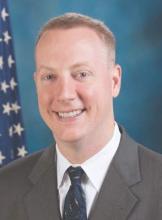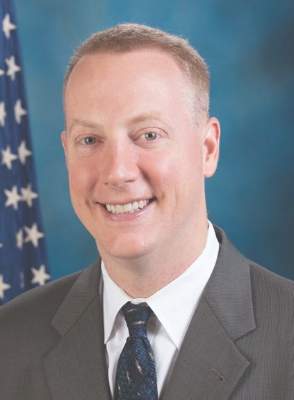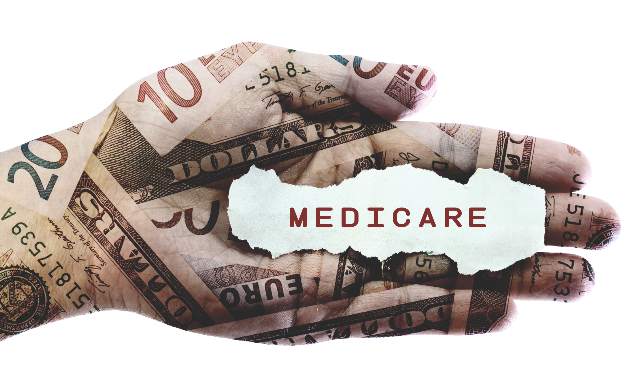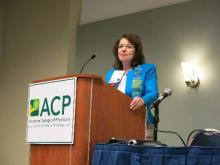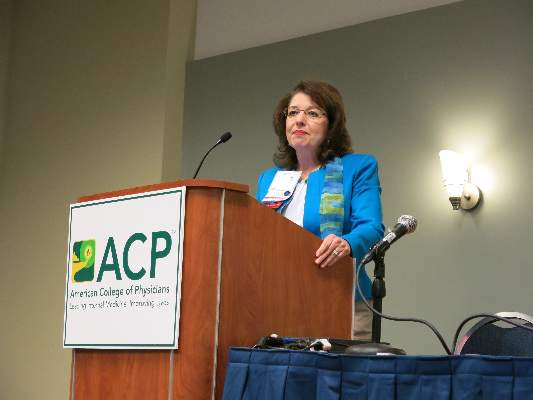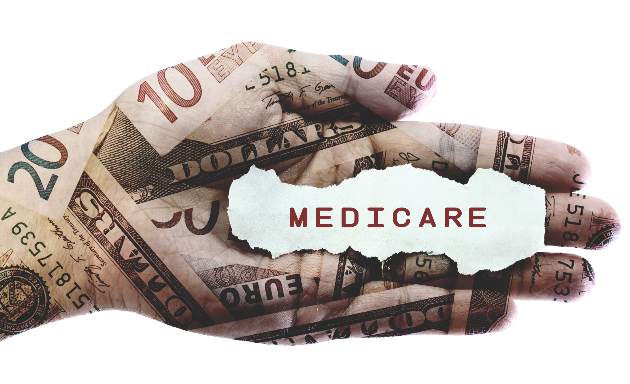User login
CMS proposes bundled payments for AMI, CABG
The Centers for Medicare & Medicaid Services is proposing new bundled payment models for acute myocardial infarction and coronary artery bypass grafting, and a separate payment to incentivize the use of cardiac rehabilitation.
As part of the proposal, CMS also is developing a pathway that would allow the bundle to be recognized as an advanced alternative payment model under the Medicare Access and CHIP Reauthorization Act and qualify the physicians and clinicians being paid through the model for the 5% incentive payment.
The proposed bundled payment model would place patient care accountability for 90 days after discharge on the hospital where acute myocardial infarction care or coronary artery bypass grafting occurred. Beginning July 1, 2017, hospitals in 98 randomly selected metropolitan statistical areas would be placed under this model and monitored for a 5-year period to test whether the model leads to improved outcomes and generates cost savings.
The proposed rule can be seen here and an advanced notice is expected to be published on the Federal Register website on July 26. CMS will be accepting comments on the proposal for 60 days following official publication in the Federal Register.
“In 2014, more than 200,000 Medicare beneficiaries were hospitalized for heart attack treatment or underwent bypass surgery, costing Medicare over $6 billion. But the cost of treating patients varied by 50% across hospitals, and the share of patients readmitted to the hospitals within 30 days varied by more than 50%. And patient experience also varies,” CMS Acting Principal Deputy Administrator and Chief Medical Officer Patrick Conway, MD, said during a July 25 press teleconference introducing the proposal. “In some cases, hospitals, doctors, and rehabilitation facilities work together to support a patient from heart attack or surgery all the way through recovery. But in other cases, coordination breaks down, especially when a patient leaves the hospital. By structuring a payment around a patient’s total experience of care, bundled payments support better care coordination and ultimately better outcomes for patients.”
The hospital would be paid a fixed target price for each care episode, with hospitals delivering higher-quality care receiving a higher target price. The hospital would either keep the savings achieved or, if the costs exceeded the target pricing, have to repay Medicare the difference.
Target prices will be based on historical cost data beginning with hospitalization and extending out 90 days following discharge and adjusted based on the complexity of treatment required. For the 18 months of the program (July 1, 2017, through Dec. 31, 2018) target prices would be based on a blend of two-thirds participant-specific data and one-third regional data. In the third performance year (2019), the mix would move to one-third participant data and two-thirds regional data. Beginning in 2020, only regional data would be used to set target prices.
For heart attacks, the following quality measures are being proposed: Hospital 30-day, all-cause, risk-standardized mortality following acute myocardial infarction hospitalization; excess days in acute care after hospitalization for acute myocardial infarction; Hospital Consumer Assessment of Healthcare Providers and Systems (HCAHPS) survey scores; and voluntary hybrid hospital 30-day, all-cause, risk-standardized mortality eMeasure data submission.
For bypass surgery, the quality measures will be the hospital 30-day all-cause, risk-standardized mortality rate following coronary artery bypass graft; and HCAHPS survey scores.
“CMS’s evaluation ... will examine quality during the episode period, after the episode period ends, and for longer durations such as 1-year mortality rates,” the agency said in a fact sheet describing the proposal. “CMS will examine outcomes and patient experience measures such as mortality, readmissions, complications, and other clinically relevant outcomes.”
Separately, the agency is proposing to test a cardiac rehabilitation incentive payment. The two-part cardiac rehabilitation incentive payment would be paid retrospectively based on the total cardiac rehabilitation use of beneficiaries attributable to participant hospitals.
“Currently, only 15% of heart attack patients receive cardiac rehabilitation, even though completing a rehabilitation program can lower the risk of the second heart attack or death,” Dr. Conway said. “Patients who receive cardiac rehabilitation are assigned a team of health care professionals such as cardiologists, dietitians, and physical therapists who help the patient to recover and regain cardiovascular fitness.”
The initial payment would be $25 per cardiac rehabilitation service for each of the first 11 services paid for by Medicare during the 90-day care period for a heart attack or bypass surgery. After 11 services, the payment would increase to $175 during the care period.
The number of sessions would be limited to two 1-hour sessions per day up to 36 sessions over up to 36 weeks, with the option for an additional 36 sessions over an extended period if approved by the local Medicare contractor. Intensive cardiac rehabilitation program sessions would be limited to 72 1-hour sessions, up to six sessions per day, over 18 weeks.
While officials from the American College of Cardiology said that the organization supports the concepts of value-based care, “it is important that bundled care models be carried out in such a way that clinicians are given the time and tools to truly impact patient care in the best ways possible. Changes in payment structures in health care can pose significant challenges to clinicians and must be driven by clinical practices that improve patient outcomes,” ACC President Richard A. Chazal, MD, said in a statement. “We are optimistic that CMS will listen to comments, incorporate feedback from clinicians, and provide ample time for implementation of these new payment models. Our ultimate goal is to improve patient care and to improve heart health.”
The Centers for Medicare & Medicaid Services is proposing new bundled payment models for acute myocardial infarction and coronary artery bypass grafting, and a separate payment to incentivize the use of cardiac rehabilitation.
As part of the proposal, CMS also is developing a pathway that would allow the bundle to be recognized as an advanced alternative payment model under the Medicare Access and CHIP Reauthorization Act and qualify the physicians and clinicians being paid through the model for the 5% incentive payment.
The proposed bundled payment model would place patient care accountability for 90 days after discharge on the hospital where acute myocardial infarction care or coronary artery bypass grafting occurred. Beginning July 1, 2017, hospitals in 98 randomly selected metropolitan statistical areas would be placed under this model and monitored for a 5-year period to test whether the model leads to improved outcomes and generates cost savings.
The proposed rule can be seen here and an advanced notice is expected to be published on the Federal Register website on July 26. CMS will be accepting comments on the proposal for 60 days following official publication in the Federal Register.
“In 2014, more than 200,000 Medicare beneficiaries were hospitalized for heart attack treatment or underwent bypass surgery, costing Medicare over $6 billion. But the cost of treating patients varied by 50% across hospitals, and the share of patients readmitted to the hospitals within 30 days varied by more than 50%. And patient experience also varies,” CMS Acting Principal Deputy Administrator and Chief Medical Officer Patrick Conway, MD, said during a July 25 press teleconference introducing the proposal. “In some cases, hospitals, doctors, and rehabilitation facilities work together to support a patient from heart attack or surgery all the way through recovery. But in other cases, coordination breaks down, especially when a patient leaves the hospital. By structuring a payment around a patient’s total experience of care, bundled payments support better care coordination and ultimately better outcomes for patients.”
The hospital would be paid a fixed target price for each care episode, with hospitals delivering higher-quality care receiving a higher target price. The hospital would either keep the savings achieved or, if the costs exceeded the target pricing, have to repay Medicare the difference.
Target prices will be based on historical cost data beginning with hospitalization and extending out 90 days following discharge and adjusted based on the complexity of treatment required. For the 18 months of the program (July 1, 2017, through Dec. 31, 2018) target prices would be based on a blend of two-thirds participant-specific data and one-third regional data. In the third performance year (2019), the mix would move to one-third participant data and two-thirds regional data. Beginning in 2020, only regional data would be used to set target prices.
For heart attacks, the following quality measures are being proposed: Hospital 30-day, all-cause, risk-standardized mortality following acute myocardial infarction hospitalization; excess days in acute care after hospitalization for acute myocardial infarction; Hospital Consumer Assessment of Healthcare Providers and Systems (HCAHPS) survey scores; and voluntary hybrid hospital 30-day, all-cause, risk-standardized mortality eMeasure data submission.
For bypass surgery, the quality measures will be the hospital 30-day all-cause, risk-standardized mortality rate following coronary artery bypass graft; and HCAHPS survey scores.
“CMS’s evaluation ... will examine quality during the episode period, after the episode period ends, and for longer durations such as 1-year mortality rates,” the agency said in a fact sheet describing the proposal. “CMS will examine outcomes and patient experience measures such as mortality, readmissions, complications, and other clinically relevant outcomes.”
Separately, the agency is proposing to test a cardiac rehabilitation incentive payment. The two-part cardiac rehabilitation incentive payment would be paid retrospectively based on the total cardiac rehabilitation use of beneficiaries attributable to participant hospitals.
“Currently, only 15% of heart attack patients receive cardiac rehabilitation, even though completing a rehabilitation program can lower the risk of the second heart attack or death,” Dr. Conway said. “Patients who receive cardiac rehabilitation are assigned a team of health care professionals such as cardiologists, dietitians, and physical therapists who help the patient to recover and regain cardiovascular fitness.”
The initial payment would be $25 per cardiac rehabilitation service for each of the first 11 services paid for by Medicare during the 90-day care period for a heart attack or bypass surgery. After 11 services, the payment would increase to $175 during the care period.
The number of sessions would be limited to two 1-hour sessions per day up to 36 sessions over up to 36 weeks, with the option for an additional 36 sessions over an extended period if approved by the local Medicare contractor. Intensive cardiac rehabilitation program sessions would be limited to 72 1-hour sessions, up to six sessions per day, over 18 weeks.
While officials from the American College of Cardiology said that the organization supports the concepts of value-based care, “it is important that bundled care models be carried out in such a way that clinicians are given the time and tools to truly impact patient care in the best ways possible. Changes in payment structures in health care can pose significant challenges to clinicians and must be driven by clinical practices that improve patient outcomes,” ACC President Richard A. Chazal, MD, said in a statement. “We are optimistic that CMS will listen to comments, incorporate feedback from clinicians, and provide ample time for implementation of these new payment models. Our ultimate goal is to improve patient care and to improve heart health.”
The Centers for Medicare & Medicaid Services is proposing new bundled payment models for acute myocardial infarction and coronary artery bypass grafting, and a separate payment to incentivize the use of cardiac rehabilitation.
As part of the proposal, CMS also is developing a pathway that would allow the bundle to be recognized as an advanced alternative payment model under the Medicare Access and CHIP Reauthorization Act and qualify the physicians and clinicians being paid through the model for the 5% incentive payment.
The proposed bundled payment model would place patient care accountability for 90 days after discharge on the hospital where acute myocardial infarction care or coronary artery bypass grafting occurred. Beginning July 1, 2017, hospitals in 98 randomly selected metropolitan statistical areas would be placed under this model and monitored for a 5-year period to test whether the model leads to improved outcomes and generates cost savings.
The proposed rule can be seen here and an advanced notice is expected to be published on the Federal Register website on July 26. CMS will be accepting comments on the proposal for 60 days following official publication in the Federal Register.
“In 2014, more than 200,000 Medicare beneficiaries were hospitalized for heart attack treatment or underwent bypass surgery, costing Medicare over $6 billion. But the cost of treating patients varied by 50% across hospitals, and the share of patients readmitted to the hospitals within 30 days varied by more than 50%. And patient experience also varies,” CMS Acting Principal Deputy Administrator and Chief Medical Officer Patrick Conway, MD, said during a July 25 press teleconference introducing the proposal. “In some cases, hospitals, doctors, and rehabilitation facilities work together to support a patient from heart attack or surgery all the way through recovery. But in other cases, coordination breaks down, especially when a patient leaves the hospital. By structuring a payment around a patient’s total experience of care, bundled payments support better care coordination and ultimately better outcomes for patients.”
The hospital would be paid a fixed target price for each care episode, with hospitals delivering higher-quality care receiving a higher target price. The hospital would either keep the savings achieved or, if the costs exceeded the target pricing, have to repay Medicare the difference.
Target prices will be based on historical cost data beginning with hospitalization and extending out 90 days following discharge and adjusted based on the complexity of treatment required. For the 18 months of the program (July 1, 2017, through Dec. 31, 2018) target prices would be based on a blend of two-thirds participant-specific data and one-third regional data. In the third performance year (2019), the mix would move to one-third participant data and two-thirds regional data. Beginning in 2020, only regional data would be used to set target prices.
For heart attacks, the following quality measures are being proposed: Hospital 30-day, all-cause, risk-standardized mortality following acute myocardial infarction hospitalization; excess days in acute care after hospitalization for acute myocardial infarction; Hospital Consumer Assessment of Healthcare Providers and Systems (HCAHPS) survey scores; and voluntary hybrid hospital 30-day, all-cause, risk-standardized mortality eMeasure data submission.
For bypass surgery, the quality measures will be the hospital 30-day all-cause, risk-standardized mortality rate following coronary artery bypass graft; and HCAHPS survey scores.
“CMS’s evaluation ... will examine quality during the episode period, after the episode period ends, and for longer durations such as 1-year mortality rates,” the agency said in a fact sheet describing the proposal. “CMS will examine outcomes and patient experience measures such as mortality, readmissions, complications, and other clinically relevant outcomes.”
Separately, the agency is proposing to test a cardiac rehabilitation incentive payment. The two-part cardiac rehabilitation incentive payment would be paid retrospectively based on the total cardiac rehabilitation use of beneficiaries attributable to participant hospitals.
“Currently, only 15% of heart attack patients receive cardiac rehabilitation, even though completing a rehabilitation program can lower the risk of the second heart attack or death,” Dr. Conway said. “Patients who receive cardiac rehabilitation are assigned a team of health care professionals such as cardiologists, dietitians, and physical therapists who help the patient to recover and regain cardiovascular fitness.”
The initial payment would be $25 per cardiac rehabilitation service for each of the first 11 services paid for by Medicare during the 90-day care period for a heart attack or bypass surgery. After 11 services, the payment would increase to $175 during the care period.
The number of sessions would be limited to two 1-hour sessions per day up to 36 sessions over up to 36 weeks, with the option for an additional 36 sessions over an extended period if approved by the local Medicare contractor. Intensive cardiac rehabilitation program sessions would be limited to 72 1-hour sessions, up to six sessions per day, over 18 weeks.
While officials from the American College of Cardiology said that the organization supports the concepts of value-based care, “it is important that bundled care models be carried out in such a way that clinicians are given the time and tools to truly impact patient care in the best ways possible. Changes in payment structures in health care can pose significant challenges to clinicians and must be driven by clinical practices that improve patient outcomes,” ACC President Richard A. Chazal, MD, said in a statement. “We are optimistic that CMS will listen to comments, incorporate feedback from clinicians, and provide ample time for implementation of these new payment models. Our ultimate goal is to improve patient care and to improve heart health.”
CMS seeks input on future of Open Payments program
The Centers for Medicare & Medicaid Services is seeking physician input on the Open Payments program.
The agency signaled its intent to gather information in its proposed Medicare Physician Fee Schedule for 2017 and will host a conference call for that purpose on August 2.
The agency already has released a slide presentation to be used during the call that highlights the information being requested, including whether the payment categories are inclusive enough; how many years of payment data is relevant; whether reporting entities should pre-vet data before reporting to the Open Payment system; the adequacy of the definition of a covered recipient teaching hospital; whether reporting entities should be able to submit data continuously throughout the calendar year; how mergers affect reporting; clarity on reporting of ownership and investment interests; clarity on the definition of physician-owned distributors; and clarity on ways to streamline the reporting process.
Details for participating in the conference call can be found here.
The Centers for Medicare & Medicaid Services is seeking physician input on the Open Payments program.
The agency signaled its intent to gather information in its proposed Medicare Physician Fee Schedule for 2017 and will host a conference call for that purpose on August 2.
The agency already has released a slide presentation to be used during the call that highlights the information being requested, including whether the payment categories are inclusive enough; how many years of payment data is relevant; whether reporting entities should pre-vet data before reporting to the Open Payment system; the adequacy of the definition of a covered recipient teaching hospital; whether reporting entities should be able to submit data continuously throughout the calendar year; how mergers affect reporting; clarity on reporting of ownership and investment interests; clarity on the definition of physician-owned distributors; and clarity on ways to streamline the reporting process.
Details for participating in the conference call can be found here.
The Centers for Medicare & Medicaid Services is seeking physician input on the Open Payments program.
The agency signaled its intent to gather information in its proposed Medicare Physician Fee Schedule for 2017 and will host a conference call for that purpose on August 2.
The agency already has released a slide presentation to be used during the call that highlights the information being requested, including whether the payment categories are inclusive enough; how many years of payment data is relevant; whether reporting entities should pre-vet data before reporting to the Open Payment system; the adequacy of the definition of a covered recipient teaching hospital; whether reporting entities should be able to submit data continuously throughout the calendar year; how mergers affect reporting; clarity on reporting of ownership and investment interests; clarity on the definition of physician-owned distributors; and clarity on ways to streamline the reporting process.
Details for participating in the conference call can be found here.
Lessons learned from merging EHR systems
WASHINGTON – As practices merge, how hard is it to merge EHRs?
Even in what might seem to be the best circumstances, it can be a huge challenge, according to Jacqueline Fincher, MD, of McDuffie Medical Associates, Thompson, Ga.
One appealing aspect of the merger of Dr. Fincher’s practice with another was that each practice used an EHR from the same vendor and each was operating with the same updates.
“This is the perfect setup,” she said at the annual meeting of the American College of Physicians. “We don’t have to go to Epic. We can stay on the same EHR. In fact, this group had gone on the same EHR back in 2006 within a month of the time that we went on; we were on the exact same version and the same everything. We were totally even. The thought among the corporate and IT staff of the new entity was that this is going to be seamless. We’re just going to renumber the accounts and everything will be just fine.”
A call to the EHR vendor, whom she did not name, revealed that the process would be anything but seamless.
“Our IT staff contacted our common EHR vendor and said we want to merge this practice with our bigger practice and the EHR company said, ‘Wow, we’ve never done that before.’ What? In this day of consolidation and integration, they had never done it before? Nor did they have a business model to do so, much less a digital plan to do so. That was pretty shocking,” she said.
Dr. Fincher noted that the EHR vendor recommended a third party vendor to handle creating an interface between the two EHRs. “Most EHR companies do not, I say, do not have a dedicated service to migrate data. It’s almost always going out to a third-party conversion service that doesn’t know you, doesn’t know your work flow, and makes everything even more difficult.”
Two and a half months – and 10 interfaces – later, the launch of the combined EHR was a disaster, Dr. Fincher said.
Even though both practices were using the exact same version of the EHR, each had very different work flows, defaults, and other nuances that meant data didn’t transfer smoothly – cheaply.
Among the surprise expenses: about $55,000 for additional hardware, network cabling and interfaces; $35,000 for additional servers; and at least $100,000 for personnel expenses related to the data migration.
Given her experience, Dr. Fincher advised her peers “to start at least 6 months in advance to map and convert the data.”
And it is vital to get input and participation from all office stakeholders – both clinical and administrative staff – regarding how the data is migrated, she said. Be sure to completely understand all work flows from both practices so that you know how the data is going to migrate.
“Understanding work flow, that is absolutely critical. Every single office has a different work flow for every type of encounter by any method. How these work flows are the same or different between your office and the new practice or your EHR and the new EHR that you’re going to, they are different. You have to understand the differences,” she added.
“We didn’t perceive that there was that much difference but when everything crashed, we discovered there were because they had different work flows, they had different defaults in place, those types of things.”
Other key questions: Which data needs to be migrated? How long should the old system remain in place? Should the data be migrated manually or digitally? How much time will the EHR merger take?
“You want to establish that structured planning time,” Dr. Fincher said. “You’ve got to carve out scheduled time with the group in order to do this. Establish the tasks that need to be accomplished, so just making a to-do list every week and who’s going to be accountable to accomplish those parts of the list” is important.
WASHINGTON – As practices merge, how hard is it to merge EHRs?
Even in what might seem to be the best circumstances, it can be a huge challenge, according to Jacqueline Fincher, MD, of McDuffie Medical Associates, Thompson, Ga.
One appealing aspect of the merger of Dr. Fincher’s practice with another was that each practice used an EHR from the same vendor and each was operating with the same updates.
“This is the perfect setup,” she said at the annual meeting of the American College of Physicians. “We don’t have to go to Epic. We can stay on the same EHR. In fact, this group had gone on the same EHR back in 2006 within a month of the time that we went on; we were on the exact same version and the same everything. We were totally even. The thought among the corporate and IT staff of the new entity was that this is going to be seamless. We’re just going to renumber the accounts and everything will be just fine.”
A call to the EHR vendor, whom she did not name, revealed that the process would be anything but seamless.
“Our IT staff contacted our common EHR vendor and said we want to merge this practice with our bigger practice and the EHR company said, ‘Wow, we’ve never done that before.’ What? In this day of consolidation and integration, they had never done it before? Nor did they have a business model to do so, much less a digital plan to do so. That was pretty shocking,” she said.
Dr. Fincher noted that the EHR vendor recommended a third party vendor to handle creating an interface between the two EHRs. “Most EHR companies do not, I say, do not have a dedicated service to migrate data. It’s almost always going out to a third-party conversion service that doesn’t know you, doesn’t know your work flow, and makes everything even more difficult.”
Two and a half months – and 10 interfaces – later, the launch of the combined EHR was a disaster, Dr. Fincher said.
Even though both practices were using the exact same version of the EHR, each had very different work flows, defaults, and other nuances that meant data didn’t transfer smoothly – cheaply.
Among the surprise expenses: about $55,000 for additional hardware, network cabling and interfaces; $35,000 for additional servers; and at least $100,000 for personnel expenses related to the data migration.
Given her experience, Dr. Fincher advised her peers “to start at least 6 months in advance to map and convert the data.”
And it is vital to get input and participation from all office stakeholders – both clinical and administrative staff – regarding how the data is migrated, she said. Be sure to completely understand all work flows from both practices so that you know how the data is going to migrate.
“Understanding work flow, that is absolutely critical. Every single office has a different work flow for every type of encounter by any method. How these work flows are the same or different between your office and the new practice or your EHR and the new EHR that you’re going to, they are different. You have to understand the differences,” she added.
“We didn’t perceive that there was that much difference but when everything crashed, we discovered there were because they had different work flows, they had different defaults in place, those types of things.”
Other key questions: Which data needs to be migrated? How long should the old system remain in place? Should the data be migrated manually or digitally? How much time will the EHR merger take?
“You want to establish that structured planning time,” Dr. Fincher said. “You’ve got to carve out scheduled time with the group in order to do this. Establish the tasks that need to be accomplished, so just making a to-do list every week and who’s going to be accountable to accomplish those parts of the list” is important.
WASHINGTON – As practices merge, how hard is it to merge EHRs?
Even in what might seem to be the best circumstances, it can be a huge challenge, according to Jacqueline Fincher, MD, of McDuffie Medical Associates, Thompson, Ga.
One appealing aspect of the merger of Dr. Fincher’s practice with another was that each practice used an EHR from the same vendor and each was operating with the same updates.
“This is the perfect setup,” she said at the annual meeting of the American College of Physicians. “We don’t have to go to Epic. We can stay on the same EHR. In fact, this group had gone on the same EHR back in 2006 within a month of the time that we went on; we were on the exact same version and the same everything. We were totally even. The thought among the corporate and IT staff of the new entity was that this is going to be seamless. We’re just going to renumber the accounts and everything will be just fine.”
A call to the EHR vendor, whom she did not name, revealed that the process would be anything but seamless.
“Our IT staff contacted our common EHR vendor and said we want to merge this practice with our bigger practice and the EHR company said, ‘Wow, we’ve never done that before.’ What? In this day of consolidation and integration, they had never done it before? Nor did they have a business model to do so, much less a digital plan to do so. That was pretty shocking,” she said.
Dr. Fincher noted that the EHR vendor recommended a third party vendor to handle creating an interface between the two EHRs. “Most EHR companies do not, I say, do not have a dedicated service to migrate data. It’s almost always going out to a third-party conversion service that doesn’t know you, doesn’t know your work flow, and makes everything even more difficult.”
Two and a half months – and 10 interfaces – later, the launch of the combined EHR was a disaster, Dr. Fincher said.
Even though both practices were using the exact same version of the EHR, each had very different work flows, defaults, and other nuances that meant data didn’t transfer smoothly – cheaply.
Among the surprise expenses: about $55,000 for additional hardware, network cabling and interfaces; $35,000 for additional servers; and at least $100,000 for personnel expenses related to the data migration.
Given her experience, Dr. Fincher advised her peers “to start at least 6 months in advance to map and convert the data.”
And it is vital to get input and participation from all office stakeholders – both clinical and administrative staff – regarding how the data is migrated, she said. Be sure to completely understand all work flows from both practices so that you know how the data is going to migrate.
“Understanding work flow, that is absolutely critical. Every single office has a different work flow for every type of encounter by any method. How these work flows are the same or different between your office and the new practice or your EHR and the new EHR that you’re going to, they are different. You have to understand the differences,” she added.
“We didn’t perceive that there was that much difference but when everything crashed, we discovered there were because they had different work flows, they had different defaults in place, those types of things.”
Other key questions: Which data needs to be migrated? How long should the old system remain in place? Should the data be migrated manually or digitally? How much time will the EHR merger take?
“You want to establish that structured planning time,” Dr. Fincher said. “You’ve got to carve out scheduled time with the group in order to do this. Establish the tasks that need to be accomplished, so just making a to-do list every week and who’s going to be accountable to accomplish those parts of the list” is important.
EXPERT ANALYSIS FROM ACP INTERNAL MEDICINE 2016
Proposed Medicare physician fee schedule update ‘a great foundation’ – ACP
First impressions of the Centers for Medicare & Medicaid Services’ proposed updated to the physician fee schedule for 2017 are positive, according to the American College of Physicians.
“We think it’s a great foundation,” Robert B. Doherty, ACP senior vice president of government affairs and public policy, said in an interview.
The proposed update, published July 15 in the Federal Register, brings in a number of new policies aimed at improving physician payment for caring for patients with multiple chronic conditions; mental and behavioral health issues; and cognitive impairment or mobility-related issues.
Among the provisions in the 800+-page proposal, are revised billing codes that would more accurately recognize the work of primary care and other cognitive specialties. The changes, according to CMS, will help “better identify and value primary care, care management, and cognitive services.” Comments on the proposed rule are due Sept. 6, 2016.
The agency is proposing a number of coding changes that “could improve health care delivery for all types of services holding the most promise for healthier people and smarter spending, and advance our health equity goals,” according to a CMS fact sheet.
The proposed fee schedule also would update how quality is measured and reported by accountable care organizations in the Medicare Shared Savings Program; align Accountable Care Organization reporting with the Physician Quality Reporting System; and change how beneficiaries are assigned to an ACO. Potentially misvalued services also would continue to be reviewed under the proposal.
“We think this is a big step forward,” Mr. Doherty said. “There is a lot in this proposed rule to strengthen primary care and particularly to reduce barriers to the ability of primary care physicians to take care of patients with chronic illnesses and patients who have mental or behavioral health conditions.”
“There are a number of specific provisions we are very happy to see in the proposed rule, including improvements in the existing codes for chronic care management, creating new codes for more complex chronic care management, simplifying the billing for those codes, creating reimbursement for a team-based primary and behavioral health care services, expansion of a program to help prevent diabetes and patients who are at high risk of developing diabetes and a whole host of other things,” he continued, adding that upon first inspection, there was nothing that stood out as being a proposal that they were not happy with, though he expects when ACP staff drills deeper into the details, the organization will make recommendations to better strengthen the overall proposal.
The agency is also proposing a code to allow for the payment of advanced care planning services furnished via telehealth.
First impressions of the Centers for Medicare & Medicaid Services’ proposed updated to the physician fee schedule for 2017 are positive, according to the American College of Physicians.
“We think it’s a great foundation,” Robert B. Doherty, ACP senior vice president of government affairs and public policy, said in an interview.
The proposed update, published July 15 in the Federal Register, brings in a number of new policies aimed at improving physician payment for caring for patients with multiple chronic conditions; mental and behavioral health issues; and cognitive impairment or mobility-related issues.
Among the provisions in the 800+-page proposal, are revised billing codes that would more accurately recognize the work of primary care and other cognitive specialties. The changes, according to CMS, will help “better identify and value primary care, care management, and cognitive services.” Comments on the proposed rule are due Sept. 6, 2016.
The agency is proposing a number of coding changes that “could improve health care delivery for all types of services holding the most promise for healthier people and smarter spending, and advance our health equity goals,” according to a CMS fact sheet.
The proposed fee schedule also would update how quality is measured and reported by accountable care organizations in the Medicare Shared Savings Program; align Accountable Care Organization reporting with the Physician Quality Reporting System; and change how beneficiaries are assigned to an ACO. Potentially misvalued services also would continue to be reviewed under the proposal.
“We think this is a big step forward,” Mr. Doherty said. “There is a lot in this proposed rule to strengthen primary care and particularly to reduce barriers to the ability of primary care physicians to take care of patients with chronic illnesses and patients who have mental or behavioral health conditions.”
“There are a number of specific provisions we are very happy to see in the proposed rule, including improvements in the existing codes for chronic care management, creating new codes for more complex chronic care management, simplifying the billing for those codes, creating reimbursement for a team-based primary and behavioral health care services, expansion of a program to help prevent diabetes and patients who are at high risk of developing diabetes and a whole host of other things,” he continued, adding that upon first inspection, there was nothing that stood out as being a proposal that they were not happy with, though he expects when ACP staff drills deeper into the details, the organization will make recommendations to better strengthen the overall proposal.
The agency is also proposing a code to allow for the payment of advanced care planning services furnished via telehealth.
First impressions of the Centers for Medicare & Medicaid Services’ proposed updated to the physician fee schedule for 2017 are positive, according to the American College of Physicians.
“We think it’s a great foundation,” Robert B. Doherty, ACP senior vice president of government affairs and public policy, said in an interview.
The proposed update, published July 15 in the Federal Register, brings in a number of new policies aimed at improving physician payment for caring for patients with multiple chronic conditions; mental and behavioral health issues; and cognitive impairment or mobility-related issues.
Among the provisions in the 800+-page proposal, are revised billing codes that would more accurately recognize the work of primary care and other cognitive specialties. The changes, according to CMS, will help “better identify and value primary care, care management, and cognitive services.” Comments on the proposed rule are due Sept. 6, 2016.
The agency is proposing a number of coding changes that “could improve health care delivery for all types of services holding the most promise for healthier people and smarter spending, and advance our health equity goals,” according to a CMS fact sheet.
The proposed fee schedule also would update how quality is measured and reported by accountable care organizations in the Medicare Shared Savings Program; align Accountable Care Organization reporting with the Physician Quality Reporting System; and change how beneficiaries are assigned to an ACO. Potentially misvalued services also would continue to be reviewed under the proposal.
“We think this is a big step forward,” Mr. Doherty said. “There is a lot in this proposed rule to strengthen primary care and particularly to reduce barriers to the ability of primary care physicians to take care of patients with chronic illnesses and patients who have mental or behavioral health conditions.”
“There are a number of specific provisions we are very happy to see in the proposed rule, including improvements in the existing codes for chronic care management, creating new codes for more complex chronic care management, simplifying the billing for those codes, creating reimbursement for a team-based primary and behavioral health care services, expansion of a program to help prevent diabetes and patients who are at high risk of developing diabetes and a whole host of other things,” he continued, adding that upon first inspection, there was nothing that stood out as being a proposal that they were not happy with, though he expects when ACP staff drills deeper into the details, the organization will make recommendations to better strengthen the overall proposal.
The agency is also proposing a code to allow for the payment of advanced care planning services furnished via telehealth.
Congress sends opioid legislation to the President
Compromise legislation to address the opioid epidemic has overwhelmingly passed both houses of Congress and been sent to President Obama, who has signaled that he will sign it begrudgingly.
“We continue to believe this bill falls far short,” according to a statement from the White House. “That’s why the administration strongly supported Democratic efforts to add $920 million in funding for states to provide treatment for Americans struggling with opioid addiction. ... While the president will sign this bill once it reaches his desk because some action is better than none, he won’t stop fighting to secure the resources this public health crisis demands.”
The final version of the Comprehensive Addiction and Recovery Act (S. 534) passed the House by a 407-5 vote and the Senate by a 92-2 vote.
The legislation allows the Health & Human Services Department to make training and education grants to address opioid addiction, as well as grants to address opioid abuse locally. HHS may also make grants to states to help pay for opioid overdose–reversal programs. It also provides $50 million over 5 years to improve state-level prescription drug-monitoring programs.
S. 524 also allows the Department of Justice to develop programs to combat opioid abuse in a number of ways. Grants would fund alternatives to incarceration programs, train first responders in using opioid overdose–reversal medications, create more prescription take-back programs, and investigative activities related to unlawful distribution of opioids.
The bill also expands access to medication-assisted treatment of opioid abuse/addiction by extending prescribing authority to certain specially trained nurse practitioners and physician assistants. It also allows Medicare Parts C and D to develop safe prescribing and dispensing programs, such as “lock-in” programs that require beneficiaries at risk for substance abuse to use a single designated source for opioid prescriptions. The legislation also has a number of provisions aimed specifically at the Department of Veterans Affairs.
In a statement, the American College of Physicians highlighted a few additional provisions that it supported, including the development of a federal task force to identify best practices for pain management and prescribing pain medication; expanding grants to education physician and other stakeholders on the risks of opioid misuse; improvements to the Prescription Drug Monitoring Program; increased availability of opioid overdose–reversal medication; and expansion of the use of partial fills for opioid prescriptions.
“This legislation takes important steps to address the growing crisis and to provide patients with greater access to care and treatment they need to deal with substance use disorders,” Nitin Damle, MD, ACP president, said in a statement.
Compromise legislation to address the opioid epidemic has overwhelmingly passed both houses of Congress and been sent to President Obama, who has signaled that he will sign it begrudgingly.
“We continue to believe this bill falls far short,” according to a statement from the White House. “That’s why the administration strongly supported Democratic efforts to add $920 million in funding for states to provide treatment for Americans struggling with opioid addiction. ... While the president will sign this bill once it reaches his desk because some action is better than none, he won’t stop fighting to secure the resources this public health crisis demands.”
The final version of the Comprehensive Addiction and Recovery Act (S. 534) passed the House by a 407-5 vote and the Senate by a 92-2 vote.
The legislation allows the Health & Human Services Department to make training and education grants to address opioid addiction, as well as grants to address opioid abuse locally. HHS may also make grants to states to help pay for opioid overdose–reversal programs. It also provides $50 million over 5 years to improve state-level prescription drug-monitoring programs.
S. 524 also allows the Department of Justice to develop programs to combat opioid abuse in a number of ways. Grants would fund alternatives to incarceration programs, train first responders in using opioid overdose–reversal medications, create more prescription take-back programs, and investigative activities related to unlawful distribution of opioids.
The bill also expands access to medication-assisted treatment of opioid abuse/addiction by extending prescribing authority to certain specially trained nurse practitioners and physician assistants. It also allows Medicare Parts C and D to develop safe prescribing and dispensing programs, such as “lock-in” programs that require beneficiaries at risk for substance abuse to use a single designated source for opioid prescriptions. The legislation also has a number of provisions aimed specifically at the Department of Veterans Affairs.
In a statement, the American College of Physicians highlighted a few additional provisions that it supported, including the development of a federal task force to identify best practices for pain management and prescribing pain medication; expanding grants to education physician and other stakeholders on the risks of opioid misuse; improvements to the Prescription Drug Monitoring Program; increased availability of opioid overdose–reversal medication; and expansion of the use of partial fills for opioid prescriptions.
“This legislation takes important steps to address the growing crisis and to provide patients with greater access to care and treatment they need to deal with substance use disorders,” Nitin Damle, MD, ACP president, said in a statement.
Compromise legislation to address the opioid epidemic has overwhelmingly passed both houses of Congress and been sent to President Obama, who has signaled that he will sign it begrudgingly.
“We continue to believe this bill falls far short,” according to a statement from the White House. “That’s why the administration strongly supported Democratic efforts to add $920 million in funding for states to provide treatment for Americans struggling with opioid addiction. ... While the president will sign this bill once it reaches his desk because some action is better than none, he won’t stop fighting to secure the resources this public health crisis demands.”
The final version of the Comprehensive Addiction and Recovery Act (S. 534) passed the House by a 407-5 vote and the Senate by a 92-2 vote.
The legislation allows the Health & Human Services Department to make training and education grants to address opioid addiction, as well as grants to address opioid abuse locally. HHS may also make grants to states to help pay for opioid overdose–reversal programs. It also provides $50 million over 5 years to improve state-level prescription drug-monitoring programs.
S. 524 also allows the Department of Justice to develop programs to combat opioid abuse in a number of ways. Grants would fund alternatives to incarceration programs, train first responders in using opioid overdose–reversal medications, create more prescription take-back programs, and investigative activities related to unlawful distribution of opioids.
The bill also expands access to medication-assisted treatment of opioid abuse/addiction by extending prescribing authority to certain specially trained nurse practitioners and physician assistants. It also allows Medicare Parts C and D to develop safe prescribing and dispensing programs, such as “lock-in” programs that require beneficiaries at risk for substance abuse to use a single designated source for opioid prescriptions. The legislation also has a number of provisions aimed specifically at the Department of Veterans Affairs.
In a statement, the American College of Physicians highlighted a few additional provisions that it supported, including the development of a federal task force to identify best practices for pain management and prescribing pain medication; expanding grants to education physician and other stakeholders on the risks of opioid misuse; improvements to the Prescription Drug Monitoring Program; increased availability of opioid overdose–reversal medication; and expansion of the use of partial fills for opioid prescriptions.
“This legislation takes important steps to address the growing crisis and to provide patients with greater access to care and treatment they need to deal with substance use disorders,” Nitin Damle, MD, ACP president, said in a statement.
CMS: Projected overall growth rate in health spending holding firm
Health spending is projected to grow on average 5.8% from 2015-2025, the same projected rate of grown as announced last year covering 2014-2024, according the CMS Office of the Actuary.
However, health care is projected to make up 20.1% of the economy at the end of the 10-year period, up from 17.5% in 2014, as health spending is projected to grow 1.3 percentage points faster than gross domestic product from 2015-2025. The analysis was published online July 13 in the journal Health Affairs.
Health spending for 2015 is projected to have grown 5.5%, up from 5.3% in 2014, and to have reached $3.2 trillion, driven in part by increased use of health services by newly insured patients. More than 9 in 10 (92%) of U.S. residents are projected to be insured by 2025, according to the actuary’s office.
While national spending per capita is projected to exceed $10,000 for the first time in 2016, spending growth is projected to slow to 4.8%, driven by slowdowns in Medicaid spending after 2 years of rapid growth.
Private health insurance expenditures are expected to grow at a similar rate (5.4%) through 2025, CMS actuaries said.
Medical price inflation slowed to 0.8% in 2015 from 1.4% in 2014. Hospital prices increased by 0.9% while prices for physician services dropped 1.1%, they noted.
Prescription drug spending is projected to grow an average of 6.7% from 2016 to 2025, slowing down from 12.2% in 2014 and 8.1% in 2015 when a number of high-priced specialty drugs, including those treating hepatitis C, were driving higher spending.
Health spending is projected to grow on average 5.8% from 2015-2025, the same projected rate of grown as announced last year covering 2014-2024, according the CMS Office of the Actuary.
However, health care is projected to make up 20.1% of the economy at the end of the 10-year period, up from 17.5% in 2014, as health spending is projected to grow 1.3 percentage points faster than gross domestic product from 2015-2025. The analysis was published online July 13 in the journal Health Affairs.
Health spending for 2015 is projected to have grown 5.5%, up from 5.3% in 2014, and to have reached $3.2 trillion, driven in part by increased use of health services by newly insured patients. More than 9 in 10 (92%) of U.S. residents are projected to be insured by 2025, according to the actuary’s office.
While national spending per capita is projected to exceed $10,000 for the first time in 2016, spending growth is projected to slow to 4.8%, driven by slowdowns in Medicaid spending after 2 years of rapid growth.
Private health insurance expenditures are expected to grow at a similar rate (5.4%) through 2025, CMS actuaries said.
Medical price inflation slowed to 0.8% in 2015 from 1.4% in 2014. Hospital prices increased by 0.9% while prices for physician services dropped 1.1%, they noted.
Prescription drug spending is projected to grow an average of 6.7% from 2016 to 2025, slowing down from 12.2% in 2014 and 8.1% in 2015 when a number of high-priced specialty drugs, including those treating hepatitis C, were driving higher spending.
Health spending is projected to grow on average 5.8% from 2015-2025, the same projected rate of grown as announced last year covering 2014-2024, according the CMS Office of the Actuary.
However, health care is projected to make up 20.1% of the economy at the end of the 10-year period, up from 17.5% in 2014, as health spending is projected to grow 1.3 percentage points faster than gross domestic product from 2015-2025. The analysis was published online July 13 in the journal Health Affairs.
Health spending for 2015 is projected to have grown 5.5%, up from 5.3% in 2014, and to have reached $3.2 trillion, driven in part by increased use of health services by newly insured patients. More than 9 in 10 (92%) of U.S. residents are projected to be insured by 2025, according to the actuary’s office.
While national spending per capita is projected to exceed $10,000 for the first time in 2016, spending growth is projected to slow to 4.8%, driven by slowdowns in Medicaid spending after 2 years of rapid growth.
Private health insurance expenditures are expected to grow at a similar rate (5.4%) through 2025, CMS actuaries said.
Medical price inflation slowed to 0.8% in 2015 from 1.4% in 2014. Hospital prices increased by 0.9% while prices for physician services dropped 1.1%, they noted.
Prescription drug spending is projected to grow an average of 6.7% from 2016 to 2025, slowing down from 12.2% in 2014 and 8.1% in 2015 when a number of high-priced specialty drugs, including those treating hepatitis C, were driving higher spending.
FROM HEALTH AFFAIRS
CMS to Congress: We might delay MACRA start
Implementation of some MACRA provisions could be delayed, CMS Acting Administrator Andy Slavitt told committee members at a July 13 hearing of the Senate Finance Committee.
Officials at the Centers for Medicare & Medicaid Services are considering “alternative start dates, looking at whether shorter periods could be used, and finding other ways for physicians to get experience with the program before the impact of it really hits them,” Mr. Slavitt testified.
Many of the comments that were submitted by physicians and other stakeholders on the proposed MACRA rule called for delayed implementation, Mr. Slavitt said. Other key themes included ensuring that patients are the focus, simplifying the rules, creating more pathways to advanced payment models, and providing a greater consideration of the needs of small and solo practices, particularly rural ones.
“We need to launch this program so that it begins on the right foot. That means that every physician in the country needs to feel like they are set up for success,” Mr. Slavitt said. He added that CMS may release an interim final rule to allow for more comment on changes stemming from the feedback received on the initial proposal.
Many Senators on the committee asked Mr. Slavitt how the proposed regulations would impact solo and small practices, especially ones in rural areas.
“The focus on small independent practices and their ability to continue to practice independently is a very high priority for us,” Mr. Slavitt said. “I would add that it’s not just small practices, it’s all also any physician that practices in a rural location. They have a very different set of dynamics than other physicians do. ... We need every physician set up for success and the challenges in small practices are far greater.”
He noted that for many small or solo practices, even a small amount of additional paperwork could affect how much time the physician can spend with patients.
Another area of concern in the MACRA regulation comments was the delay in the development of virtual groups that would allow physicians to virtually pool reporting requirements to allow for greater participation in value-based programs. The proposed MACRA rule calls for these groups to be delayed for 1 year .
“I think this going to be a high priority for us, and I think it’s going to be something that is going to need a lot more input from physicians to make sure we get it right,” Mr. Slavitt said. Virtual groups are “a whole new way of reporting, and we need to make a number of decisions, and physicians would need to make a number of decisions and they are not yet used to practicing that way.”
He added that CMS is asking physicians how they want to go about it, and the feedback so far is promising that physicians want to participate, but there needs to be operational and technology infrastructure to make it happen.
“I don’t think this is something that can’t be solved with just a little bit more time, but it’s certainly not something that’s ready to be launched in months,” he said, adding that the agency aims to launch virtual group reporting in the second year of the MACRA implementation.
Implementation of some MACRA provisions could be delayed, CMS Acting Administrator Andy Slavitt told committee members at a July 13 hearing of the Senate Finance Committee.
Officials at the Centers for Medicare & Medicaid Services are considering “alternative start dates, looking at whether shorter periods could be used, and finding other ways for physicians to get experience with the program before the impact of it really hits them,” Mr. Slavitt testified.
Many of the comments that were submitted by physicians and other stakeholders on the proposed MACRA rule called for delayed implementation, Mr. Slavitt said. Other key themes included ensuring that patients are the focus, simplifying the rules, creating more pathways to advanced payment models, and providing a greater consideration of the needs of small and solo practices, particularly rural ones.
“We need to launch this program so that it begins on the right foot. That means that every physician in the country needs to feel like they are set up for success,” Mr. Slavitt said. He added that CMS may release an interim final rule to allow for more comment on changes stemming from the feedback received on the initial proposal.
Many Senators on the committee asked Mr. Slavitt how the proposed regulations would impact solo and small practices, especially ones in rural areas.
“The focus on small independent practices and their ability to continue to practice independently is a very high priority for us,” Mr. Slavitt said. “I would add that it’s not just small practices, it’s all also any physician that practices in a rural location. They have a very different set of dynamics than other physicians do. ... We need every physician set up for success and the challenges in small practices are far greater.”
He noted that for many small or solo practices, even a small amount of additional paperwork could affect how much time the physician can spend with patients.
Another area of concern in the MACRA regulation comments was the delay in the development of virtual groups that would allow physicians to virtually pool reporting requirements to allow for greater participation in value-based programs. The proposed MACRA rule calls for these groups to be delayed for 1 year .
“I think this going to be a high priority for us, and I think it’s going to be something that is going to need a lot more input from physicians to make sure we get it right,” Mr. Slavitt said. Virtual groups are “a whole new way of reporting, and we need to make a number of decisions, and physicians would need to make a number of decisions and they are not yet used to practicing that way.”
He added that CMS is asking physicians how they want to go about it, and the feedback so far is promising that physicians want to participate, but there needs to be operational and technology infrastructure to make it happen.
“I don’t think this is something that can’t be solved with just a little bit more time, but it’s certainly not something that’s ready to be launched in months,” he said, adding that the agency aims to launch virtual group reporting in the second year of the MACRA implementation.
Implementation of some MACRA provisions could be delayed, CMS Acting Administrator Andy Slavitt told committee members at a July 13 hearing of the Senate Finance Committee.
Officials at the Centers for Medicare & Medicaid Services are considering “alternative start dates, looking at whether shorter periods could be used, and finding other ways for physicians to get experience with the program before the impact of it really hits them,” Mr. Slavitt testified.
Many of the comments that were submitted by physicians and other stakeholders on the proposed MACRA rule called for delayed implementation, Mr. Slavitt said. Other key themes included ensuring that patients are the focus, simplifying the rules, creating more pathways to advanced payment models, and providing a greater consideration of the needs of small and solo practices, particularly rural ones.
“We need to launch this program so that it begins on the right foot. That means that every physician in the country needs to feel like they are set up for success,” Mr. Slavitt said. He added that CMS may release an interim final rule to allow for more comment on changes stemming from the feedback received on the initial proposal.
Many Senators on the committee asked Mr. Slavitt how the proposed regulations would impact solo and small practices, especially ones in rural areas.
“The focus on small independent practices and their ability to continue to practice independently is a very high priority for us,” Mr. Slavitt said. “I would add that it’s not just small practices, it’s all also any physician that practices in a rural location. They have a very different set of dynamics than other physicians do. ... We need every physician set up for success and the challenges in small practices are far greater.”
He noted that for many small or solo practices, even a small amount of additional paperwork could affect how much time the physician can spend with patients.
Another area of concern in the MACRA regulation comments was the delay in the development of virtual groups that would allow physicians to virtually pool reporting requirements to allow for greater participation in value-based programs. The proposed MACRA rule calls for these groups to be delayed for 1 year .
“I think this going to be a high priority for us, and I think it’s going to be something that is going to need a lot more input from physicians to make sure we get it right,” Mr. Slavitt said. Virtual groups are “a whole new way of reporting, and we need to make a number of decisions, and physicians would need to make a number of decisions and they are not yet used to practicing that way.”
He added that CMS is asking physicians how they want to go about it, and the feedback so far is promising that physicians want to participate, but there needs to be operational and technology infrastructure to make it happen.
“I don’t think this is something that can’t be solved with just a little bit more time, but it’s certainly not something that’s ready to be launched in months,” he said, adding that the agency aims to launch virtual group reporting in the second year of the MACRA implementation.
FROM A SENATE FINANCE COMMITTEE HEARING
HHS issues guidance on ransomware attacks
The U.S. Department of Health & Human Services’ Office of Civil Rights has issued new guidance to help physicians and their practices combat a ransomware attack.
Ransomware – a type of malicious software designed to block access to a computer system until a sum of money is paid – is becoming a bigger problem for U.S. businesses in general. Daily ransomware attacks against all types of computer systems increased 300% in early 2016 to 4,000, from 1,000 daily attacks in 2015, according to the Department of Justice.
The HHS fact sheet offers information on how HIPAA compliance can help protect and recover infected systems; how to detect if systems are infected; and what to do if a system becomes infected, including what is reportable.
There are “measures known to be effective to prevent the introduction of ransomware and to recover from a ransomware attack,” according to HHS.
The U.S. Department of Health & Human Services’ Office of Civil Rights has issued new guidance to help physicians and their practices combat a ransomware attack.
Ransomware – a type of malicious software designed to block access to a computer system until a sum of money is paid – is becoming a bigger problem for U.S. businesses in general. Daily ransomware attacks against all types of computer systems increased 300% in early 2016 to 4,000, from 1,000 daily attacks in 2015, according to the Department of Justice.
The HHS fact sheet offers information on how HIPAA compliance can help protect and recover infected systems; how to detect if systems are infected; and what to do if a system becomes infected, including what is reportable.
There are “measures known to be effective to prevent the introduction of ransomware and to recover from a ransomware attack,” according to HHS.
The U.S. Department of Health & Human Services’ Office of Civil Rights has issued new guidance to help physicians and their practices combat a ransomware attack.
Ransomware – a type of malicious software designed to block access to a computer system until a sum of money is paid – is becoming a bigger problem for U.S. businesses in general. Daily ransomware attacks against all types of computer systems increased 300% in early 2016 to 4,000, from 1,000 daily attacks in 2015, according to the Department of Justice.
The HHS fact sheet offers information on how HIPAA compliance can help protect and recover infected systems; how to detect if systems are infected; and what to do if a system becomes infected, including what is reportable.
There are “measures known to be effective to prevent the introduction of ransomware and to recover from a ransomware attack,” according to HHS.
Docs to CMS: MACRA is too complex and should be delayed
The proposed federal regulations to implement the MACRA health care reforms are too complex, too onerous on small and solo practices, lack opportunities for many to participate in alternative payment models, and should be delayed for a full year, at least.
That was the message that emerged from hundreds of comments regarding the proposed rule that were submitted by physician organizations and other stakeholders.
“The intent of [the Medicare Access and CHIP Reauthorization Act of 2015] was not to merely move the current incentive program into [the Merit-based Incentive Payment System], but to improve and simplify these programs into a single more unified approach,” the American Medical Association said in its comments, noting that “numerous changes” will be needed in the way cost and quality are measured.
AMA also called for a better, faster way for physicians to develop alternative payment models. “We strongly urge CMS to vigorously pursue this objective and establish a much more progressive and welcoming environment for the development and implementation of specialty-defined APMs than proposed in the [proposed rule].”
AMA also suggested that CMS provide more flexibility for solo and small practices, align the four components of MIPS so it operates as a single program, simplifying and lowering the financial risk for advanced APMs, and providing more timely feedback to physicians.
The organization also called for CMS to “create an initial transitional performance period from July 1, 2017, to December 31, 2017, to ensure the successful and appropriate implementation of the MACRA program. In future years, for all reporting requirements, CMS should allow physicians to select periods of less than a full calendar year to provide flexibility.”
In its comments, the American Medical Group Association questioned whether the proposed rule actually would lead to improved quality of care and reward value.
In the proposed rule, “CMS will measure and score quality and resource use or spending separately,” AMGA wrote in its comments. “CMS will not measure outcomes in relation to spending. CMS will not measure for value. If value is left unaddressed in the final rule, it will be difficult at best for the agency to meet MACRA and the [HHS] secretary’s overarching goals.”
While expressing support for MACRA conceptually, officials with the American Academy of Family Physicians wrote that they “see a strong and definite need and opportunity for CMS to step back and reconsider the approach to this proposed rule which we view as overly complex and burdensome to our members and indeed for all physicians. Given the significant complexity of the rule, we strongly encourage CMS to issue an interim final rule with comment period rather than to issue a final rule.”
Specifically, AAFP criticized the proposed rule for allowing small and solo practices to form “virtual groups” in order to earn bonuses, despite it being mandated by law.
Solo and small group practices who participate in MIPS to should “be eligible for positive payment updates if their performance yields such payments, but would be exempt from any negative payment update until such a time that the virtual group option is available,” AAFP officials wrote.
They also called for medical home delivery models to be included in APMs, in an effort to improve on the limited opportunities for family practices in particular to participate in alternative payment models.
The American College of Physicians also called for safe harbors for small and solo practices until virtual group options can be established.
ACP, like other groups, questioned that medical homes are not recognized as alternative payment models and argued that Congress intended medical homes to qualify as APMs “without bearing more than nominal financial risk.”
Despite the flexible approach to the overall quality payment program, CMS has “created a degree of complexity” and must “continue to seek ways to further streamline and simplify” the move to quality payments, according to comments from the American College of Cardiology.
The ACC also expressed concerns that the reporting requirements under MIPS and some of the APMs will limit the ability for cardiologists to report the most meaningful measures, particularly if they are part of a multi-specialty group, and suggested changes in scoring methodology or to allow more than one data file to be submitted in multi-specialty situations.
It also expressed concerns that the rule as proposed could adversely effect small practices, rural practices, and practices in health professional shortage areas, and “in the absence of other solutions such as virtual groups in 2017, CMS should monitor policies and provide effective practice assistance to these practices.”
The proposed rule provides no support for small practices, according to the American Gastroenterological Association.
“Upon release of the proposed rule, we were disappointed to see that not only will APMs be essentially closed off to small practices in the first years of implementation, but the MIPS program will significantly harm practices with less than 25 eligible clinicians,” AGA noted, citing data presented by CMS that 87% of solo practitioners will receive a negative adjustment with an aggregate negative impact of $300 million and for all practices with less than 25 eligible clinicians, the aggregate negative adjustment will total $649 million.
“Any system in which smaller practices are so heavily disadvantaged is unacceptable,” AGA said. CMS has previously stated that the regulatory impact statement would likely change and reflect a smaller impact for small and solo practices once more updated information can be modeled when the rule is final.
Additionally, AGA expressed concern over the limited engagement in APMs that will be possible under the proposed rule. “Given the importance of APM participation to both the practice and reimbursement of Medicare physicians, access to advanced APMs should be provided to all physicians.”
The association also expressed concern that the definition of APM is not broad enough and suggested that it be widened in scope so that it can capture payment models that have been created using the AGA’s Roadmap to the Future of GI Practice. It recommended a number of models be classified as APMs, including the colonoscopy bundled payment, gastroesophageal reflux disease episode payment, obesity bundled payment, Project Sonar (a chronic disease management program for IBD), and the Medical Home Neighbor.
The American College of Rheumatology called for a delay in the implementation of any final MACRA regulations, noting in its comments that with requirements set to begin in 2017, the current implementation schedule “does not provide enough time for providers to implement the required changes,” though ACR does not recommend a specific start time.
ACR also questioned how the criteria for APMs was set up, noting expressly that Physician Focused Payment Models may not meet the APM requirements. The group is seeking clarification on whether these models will qualify as an APM.
“Medical home APMs should also permit specialty physicians to participate, including small group and multispeciality groups, in keeping with the need for APMs to be flexible with their criteria and the role of specialty physicians in providing chronic care.
The American Academy of Dermatology Association echoed a number of concerns voiced across the medical profession and is calling for a delay in the implementation of MACRA’s regulations.
In particular, AADA noted that the regulations are not friendly for small and solo practices in general and little is contained within the proposal to “meaningfully engage specialist physicians in APMs.”
The association also is calling for broader mechanisms to allow for the development and recognition of APMs, including recognizing specialty-focused medical homes.
The group also is calling for pilot programs to test the validity of the measures that will form the basis of quality payment incentives and penalties.
In an effort to protect small and solo practices, AADA is calling for an exemption from MIPS or APM requirements until a virtual group option is developed, tested, and is fully operational.
The American Psychiatric Association echoed a number of broad concerns raised across the physician spectrum, including calling for a to the first year of implementation to July 1, 2017, and lasting through Dec. 31, 2017, as well as enabling the formation of virtual groups at the onset of implementation in its comments.
But APA also noted that mental health presents a variety of unique issues that need to be addressed.
For example, the association notes that psychiatrists work across a number of practice settings, including academic health centers, hospitals, clinics, nursing homes, and private practices, as well as offering services via telemedicine.
“This makes it difficult for psychiatrists to capture all the work they do, because of the combination of settings that utilize multiple, and potentially differing reporting programs and methods,” APA noted.
It added that psychiatrists generally have limited time and resources that can be devoted to Medicare quality reporting, which would make participation in MIPS and APMs more challenging, particularly because many operate in small or solo practices that do not own electronic health record systems, which would complicate reporting requirements to qualify for MIPS or APMs.
In addition to concerns with reporting in general, APA said that psychiatrists “also have limited choices in outcome quality measures.”
The proposed federal regulations to implement the MACRA health care reforms are too complex, too onerous on small and solo practices, lack opportunities for many to participate in alternative payment models, and should be delayed for a full year, at least.
That was the message that emerged from hundreds of comments regarding the proposed rule that were submitted by physician organizations and other stakeholders.
“The intent of [the Medicare Access and CHIP Reauthorization Act of 2015] was not to merely move the current incentive program into [the Merit-based Incentive Payment System], but to improve and simplify these programs into a single more unified approach,” the American Medical Association said in its comments, noting that “numerous changes” will be needed in the way cost and quality are measured.
AMA also called for a better, faster way for physicians to develop alternative payment models. “We strongly urge CMS to vigorously pursue this objective and establish a much more progressive and welcoming environment for the development and implementation of specialty-defined APMs than proposed in the [proposed rule].”
AMA also suggested that CMS provide more flexibility for solo and small practices, align the four components of MIPS so it operates as a single program, simplifying and lowering the financial risk for advanced APMs, and providing more timely feedback to physicians.
The organization also called for CMS to “create an initial transitional performance period from July 1, 2017, to December 31, 2017, to ensure the successful and appropriate implementation of the MACRA program. In future years, for all reporting requirements, CMS should allow physicians to select periods of less than a full calendar year to provide flexibility.”
In its comments, the American Medical Group Association questioned whether the proposed rule actually would lead to improved quality of care and reward value.
In the proposed rule, “CMS will measure and score quality and resource use or spending separately,” AMGA wrote in its comments. “CMS will not measure outcomes in relation to spending. CMS will not measure for value. If value is left unaddressed in the final rule, it will be difficult at best for the agency to meet MACRA and the [HHS] secretary’s overarching goals.”
While expressing support for MACRA conceptually, officials with the American Academy of Family Physicians wrote that they “see a strong and definite need and opportunity for CMS to step back and reconsider the approach to this proposed rule which we view as overly complex and burdensome to our members and indeed for all physicians. Given the significant complexity of the rule, we strongly encourage CMS to issue an interim final rule with comment period rather than to issue a final rule.”
Specifically, AAFP criticized the proposed rule for allowing small and solo practices to form “virtual groups” in order to earn bonuses, despite it being mandated by law.
Solo and small group practices who participate in MIPS to should “be eligible for positive payment updates if their performance yields such payments, but would be exempt from any negative payment update until such a time that the virtual group option is available,” AAFP officials wrote.
They also called for medical home delivery models to be included in APMs, in an effort to improve on the limited opportunities for family practices in particular to participate in alternative payment models.
The American College of Physicians also called for safe harbors for small and solo practices until virtual group options can be established.
ACP, like other groups, questioned that medical homes are not recognized as alternative payment models and argued that Congress intended medical homes to qualify as APMs “without bearing more than nominal financial risk.”
Despite the flexible approach to the overall quality payment program, CMS has “created a degree of complexity” and must “continue to seek ways to further streamline and simplify” the move to quality payments, according to comments from the American College of Cardiology.
The ACC also expressed concerns that the reporting requirements under MIPS and some of the APMs will limit the ability for cardiologists to report the most meaningful measures, particularly if they are part of a multi-specialty group, and suggested changes in scoring methodology or to allow more than one data file to be submitted in multi-specialty situations.
It also expressed concerns that the rule as proposed could adversely effect small practices, rural practices, and practices in health professional shortage areas, and “in the absence of other solutions such as virtual groups in 2017, CMS should monitor policies and provide effective practice assistance to these practices.”
The proposed rule provides no support for small practices, according to the American Gastroenterological Association.
“Upon release of the proposed rule, we were disappointed to see that not only will APMs be essentially closed off to small practices in the first years of implementation, but the MIPS program will significantly harm practices with less than 25 eligible clinicians,” AGA noted, citing data presented by CMS that 87% of solo practitioners will receive a negative adjustment with an aggregate negative impact of $300 million and for all practices with less than 25 eligible clinicians, the aggregate negative adjustment will total $649 million.
“Any system in which smaller practices are so heavily disadvantaged is unacceptable,” AGA said. CMS has previously stated that the regulatory impact statement would likely change and reflect a smaller impact for small and solo practices once more updated information can be modeled when the rule is final.
Additionally, AGA expressed concern over the limited engagement in APMs that will be possible under the proposed rule. “Given the importance of APM participation to both the practice and reimbursement of Medicare physicians, access to advanced APMs should be provided to all physicians.”
The association also expressed concern that the definition of APM is not broad enough and suggested that it be widened in scope so that it can capture payment models that have been created using the AGA’s Roadmap to the Future of GI Practice. It recommended a number of models be classified as APMs, including the colonoscopy bundled payment, gastroesophageal reflux disease episode payment, obesity bundled payment, Project Sonar (a chronic disease management program for IBD), and the Medical Home Neighbor.
The American College of Rheumatology called for a delay in the implementation of any final MACRA regulations, noting in its comments that with requirements set to begin in 2017, the current implementation schedule “does not provide enough time for providers to implement the required changes,” though ACR does not recommend a specific start time.
ACR also questioned how the criteria for APMs was set up, noting expressly that Physician Focused Payment Models may not meet the APM requirements. The group is seeking clarification on whether these models will qualify as an APM.
“Medical home APMs should also permit specialty physicians to participate, including small group and multispeciality groups, in keeping with the need for APMs to be flexible with their criteria and the role of specialty physicians in providing chronic care.
The American Academy of Dermatology Association echoed a number of concerns voiced across the medical profession and is calling for a delay in the implementation of MACRA’s regulations.
In particular, AADA noted that the regulations are not friendly for small and solo practices in general and little is contained within the proposal to “meaningfully engage specialist physicians in APMs.”
The association also is calling for broader mechanisms to allow for the development and recognition of APMs, including recognizing specialty-focused medical homes.
The group also is calling for pilot programs to test the validity of the measures that will form the basis of quality payment incentives and penalties.
In an effort to protect small and solo practices, AADA is calling for an exemption from MIPS or APM requirements until a virtual group option is developed, tested, and is fully operational.
The American Psychiatric Association echoed a number of broad concerns raised across the physician spectrum, including calling for a to the first year of implementation to July 1, 2017, and lasting through Dec. 31, 2017, as well as enabling the formation of virtual groups at the onset of implementation in its comments.
But APA also noted that mental health presents a variety of unique issues that need to be addressed.
For example, the association notes that psychiatrists work across a number of practice settings, including academic health centers, hospitals, clinics, nursing homes, and private practices, as well as offering services via telemedicine.
“This makes it difficult for psychiatrists to capture all the work they do, because of the combination of settings that utilize multiple, and potentially differing reporting programs and methods,” APA noted.
It added that psychiatrists generally have limited time and resources that can be devoted to Medicare quality reporting, which would make participation in MIPS and APMs more challenging, particularly because many operate in small or solo practices that do not own electronic health record systems, which would complicate reporting requirements to qualify for MIPS or APMs.
In addition to concerns with reporting in general, APA said that psychiatrists “also have limited choices in outcome quality measures.”
The proposed federal regulations to implement the MACRA health care reforms are too complex, too onerous on small and solo practices, lack opportunities for many to participate in alternative payment models, and should be delayed for a full year, at least.
That was the message that emerged from hundreds of comments regarding the proposed rule that were submitted by physician organizations and other stakeholders.
“The intent of [the Medicare Access and CHIP Reauthorization Act of 2015] was not to merely move the current incentive program into [the Merit-based Incentive Payment System], but to improve and simplify these programs into a single more unified approach,” the American Medical Association said in its comments, noting that “numerous changes” will be needed in the way cost and quality are measured.
AMA also called for a better, faster way for physicians to develop alternative payment models. “We strongly urge CMS to vigorously pursue this objective and establish a much more progressive and welcoming environment for the development and implementation of specialty-defined APMs than proposed in the [proposed rule].”
AMA also suggested that CMS provide more flexibility for solo and small practices, align the four components of MIPS so it operates as a single program, simplifying and lowering the financial risk for advanced APMs, and providing more timely feedback to physicians.
The organization also called for CMS to “create an initial transitional performance period from July 1, 2017, to December 31, 2017, to ensure the successful and appropriate implementation of the MACRA program. In future years, for all reporting requirements, CMS should allow physicians to select periods of less than a full calendar year to provide flexibility.”
In its comments, the American Medical Group Association questioned whether the proposed rule actually would lead to improved quality of care and reward value.
In the proposed rule, “CMS will measure and score quality and resource use or spending separately,” AMGA wrote in its comments. “CMS will not measure outcomes in relation to spending. CMS will not measure for value. If value is left unaddressed in the final rule, it will be difficult at best for the agency to meet MACRA and the [HHS] secretary’s overarching goals.”
While expressing support for MACRA conceptually, officials with the American Academy of Family Physicians wrote that they “see a strong and definite need and opportunity for CMS to step back and reconsider the approach to this proposed rule which we view as overly complex and burdensome to our members and indeed for all physicians. Given the significant complexity of the rule, we strongly encourage CMS to issue an interim final rule with comment period rather than to issue a final rule.”
Specifically, AAFP criticized the proposed rule for allowing small and solo practices to form “virtual groups” in order to earn bonuses, despite it being mandated by law.
Solo and small group practices who participate in MIPS to should “be eligible for positive payment updates if their performance yields such payments, but would be exempt from any negative payment update until such a time that the virtual group option is available,” AAFP officials wrote.
They also called for medical home delivery models to be included in APMs, in an effort to improve on the limited opportunities for family practices in particular to participate in alternative payment models.
The American College of Physicians also called for safe harbors for small and solo practices until virtual group options can be established.
ACP, like other groups, questioned that medical homes are not recognized as alternative payment models and argued that Congress intended medical homes to qualify as APMs “without bearing more than nominal financial risk.”
Despite the flexible approach to the overall quality payment program, CMS has “created a degree of complexity” and must “continue to seek ways to further streamline and simplify” the move to quality payments, according to comments from the American College of Cardiology.
The ACC also expressed concerns that the reporting requirements under MIPS and some of the APMs will limit the ability for cardiologists to report the most meaningful measures, particularly if they are part of a multi-specialty group, and suggested changes in scoring methodology or to allow more than one data file to be submitted in multi-specialty situations.
It also expressed concerns that the rule as proposed could adversely effect small practices, rural practices, and practices in health professional shortage areas, and “in the absence of other solutions such as virtual groups in 2017, CMS should monitor policies and provide effective practice assistance to these practices.”
The proposed rule provides no support for small practices, according to the American Gastroenterological Association.
“Upon release of the proposed rule, we were disappointed to see that not only will APMs be essentially closed off to small practices in the first years of implementation, but the MIPS program will significantly harm practices with less than 25 eligible clinicians,” AGA noted, citing data presented by CMS that 87% of solo practitioners will receive a negative adjustment with an aggregate negative impact of $300 million and for all practices with less than 25 eligible clinicians, the aggregate negative adjustment will total $649 million.
“Any system in which smaller practices are so heavily disadvantaged is unacceptable,” AGA said. CMS has previously stated that the regulatory impact statement would likely change and reflect a smaller impact for small and solo practices once more updated information can be modeled when the rule is final.
Additionally, AGA expressed concern over the limited engagement in APMs that will be possible under the proposed rule. “Given the importance of APM participation to both the practice and reimbursement of Medicare physicians, access to advanced APMs should be provided to all physicians.”
The association also expressed concern that the definition of APM is not broad enough and suggested that it be widened in scope so that it can capture payment models that have been created using the AGA’s Roadmap to the Future of GI Practice. It recommended a number of models be classified as APMs, including the colonoscopy bundled payment, gastroesophageal reflux disease episode payment, obesity bundled payment, Project Sonar (a chronic disease management program for IBD), and the Medical Home Neighbor.
The American College of Rheumatology called for a delay in the implementation of any final MACRA regulations, noting in its comments that with requirements set to begin in 2017, the current implementation schedule “does not provide enough time for providers to implement the required changes,” though ACR does not recommend a specific start time.
ACR also questioned how the criteria for APMs was set up, noting expressly that Physician Focused Payment Models may not meet the APM requirements. The group is seeking clarification on whether these models will qualify as an APM.
“Medical home APMs should also permit specialty physicians to participate, including small group and multispeciality groups, in keeping with the need for APMs to be flexible with their criteria and the role of specialty physicians in providing chronic care.
The American Academy of Dermatology Association echoed a number of concerns voiced across the medical profession and is calling for a delay in the implementation of MACRA’s regulations.
In particular, AADA noted that the regulations are not friendly for small and solo practices in general and little is contained within the proposal to “meaningfully engage specialist physicians in APMs.”
The association also is calling for broader mechanisms to allow for the development and recognition of APMs, including recognizing specialty-focused medical homes.
The group also is calling for pilot programs to test the validity of the measures that will form the basis of quality payment incentives and penalties.
In an effort to protect small and solo practices, AADA is calling for an exemption from MIPS or APM requirements until a virtual group option is developed, tested, and is fully operational.
The American Psychiatric Association echoed a number of broad concerns raised across the physician spectrum, including calling for a to the first year of implementation to July 1, 2017, and lasting through Dec. 31, 2017, as well as enabling the formation of virtual groups at the onset of implementation in its comments.
But APA also noted that mental health presents a variety of unique issues that need to be addressed.
For example, the association notes that psychiatrists work across a number of practice settings, including academic health centers, hospitals, clinics, nursing homes, and private practices, as well as offering services via telemedicine.
“This makes it difficult for psychiatrists to capture all the work they do, because of the combination of settings that utilize multiple, and potentially differing reporting programs and methods,” APA noted.
It added that psychiatrists generally have limited time and resources that can be devoted to Medicare quality reporting, which would make participation in MIPS and APMs more challenging, particularly because many operate in small or solo practices that do not own electronic health record systems, which would complicate reporting requirements to qualify for MIPS or APMs.
In addition to concerns with reporting in general, APA said that psychiatrists “also have limited choices in outcome quality measures.”
Multisite NIH-sponsored research can now use single IRB
In an effort to streamline multisite clinical research, the National Institutes of Health announced a new policy related to the use of institutional review boards (IRBs).
The new policy sets “the expectation that multisite studies conducting the same protocol use a single IRB to carry out the ethical review of the proposed research,” NIH Director Francis S. Collins, MD, said in a June 21 statement. The policy goes into effect May 25, 2017, and applies only to domestic research.
Currently, for most multisite studies, the IRB at each site conducts an independent review of protocol and consent documents, which Dr. Collins said “adds time, but generally does not meaningfully enhance protections for the participants. This new NIH policy seeks to end duplicative reviews that slow down the start of the research.”
Michael Pichichero, MD, director of the research institute, Rochester (N.Y.) General Hospital, called the change “a good policy. Allowing a single IRB to review and not go through multiple reviews will help get clinical trials going faster,” he said in an interview. “The policies and principles of IRB review are the same for all U.S. Food and Drug Administration–approved IRBs, so the concern that inappropriate approval might be given is highly unlikely.”
In an effort to streamline multisite clinical research, the National Institutes of Health announced a new policy related to the use of institutional review boards (IRBs).
The new policy sets “the expectation that multisite studies conducting the same protocol use a single IRB to carry out the ethical review of the proposed research,” NIH Director Francis S. Collins, MD, said in a June 21 statement. The policy goes into effect May 25, 2017, and applies only to domestic research.
Currently, for most multisite studies, the IRB at each site conducts an independent review of protocol and consent documents, which Dr. Collins said “adds time, but generally does not meaningfully enhance protections for the participants. This new NIH policy seeks to end duplicative reviews that slow down the start of the research.”
Michael Pichichero, MD, director of the research institute, Rochester (N.Y.) General Hospital, called the change “a good policy. Allowing a single IRB to review and not go through multiple reviews will help get clinical trials going faster,” he said in an interview. “The policies and principles of IRB review are the same for all U.S. Food and Drug Administration–approved IRBs, so the concern that inappropriate approval might be given is highly unlikely.”
In an effort to streamline multisite clinical research, the National Institutes of Health announced a new policy related to the use of institutional review boards (IRBs).
The new policy sets “the expectation that multisite studies conducting the same protocol use a single IRB to carry out the ethical review of the proposed research,” NIH Director Francis S. Collins, MD, said in a June 21 statement. The policy goes into effect May 25, 2017, and applies only to domestic research.
Currently, for most multisite studies, the IRB at each site conducts an independent review of protocol and consent documents, which Dr. Collins said “adds time, but generally does not meaningfully enhance protections for the participants. This new NIH policy seeks to end duplicative reviews that slow down the start of the research.”
Michael Pichichero, MD, director of the research institute, Rochester (N.Y.) General Hospital, called the change “a good policy. Allowing a single IRB to review and not go through multiple reviews will help get clinical trials going faster,” he said in an interview. “The policies and principles of IRB review are the same for all U.S. Food and Drug Administration–approved IRBs, so the concern that inappropriate approval might be given is highly unlikely.”
